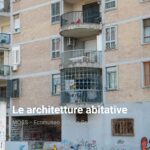LE ARCHITETTURE ABITATIVE
Nè gli anonimi palazzoni, nè le cinematografiche vele, nè le baracche autocostruite, sono luoghi neutri o solo connotati negativamente — brutti, fatiscenti, degradanti, disumani — e in tutti si mischiano le piccole storie di vita degli abitanti con quelli della grande storia delle trasformazioni urbanistiche della città di Napoli.
Neither the anonymous palazzoni, nor the cinematic vele, nor the self-built shacks, are neutral places or only negatively connoted – ugly, dilapidated, degrading, inhuman – and in all of them the small life stories of the inhabitants are mixed with those of the great history of the urban transformations of the city of Naples.
Scampia è un quartiere giovane in cui vivono oltre 60.000 persone. L’urbanizzazione di Scampia inizia dagli anni ’70, dove da borgo a vocazione agricola diventa un quartiere ad alta densità abitativa, con un boom di espansione edilizia, appartenente alla 8° Municipalità di Napoli. Si sono avvicendati e convivono sullo stesso territorio interventi di edilizia residenziale pubblica – tra cui le Vele, da alcuni anni oggetto di un nuovo piano di riqualificazione territoriale che passa per il loro abbattimento e trasferimento degli abitanti in nuovi alloggi residenziali – i parchi recintati delle cooperative private, le baracche autocostruite della zona di Cupa Perillo, al confine del quartiere, in cui vivono comunità rom di antico insediamento. Il diritto all’abitare non è garantito per tutte e tutti, come testimoniano la diffusione di case occupate e l’incapacità decennale di trovare soluzioni abitative non ghettizzanti per le comunità rom, presenti da oltre due generazioni.
Scampia is a young neighbourhood in which more than 60,000 people live. The urbanisation of Scampia began in the 1970s, when it went from being an agricultural suburb to a high-density neighbourhood with a building boom, belonging to the 8th Municipality of Naples. Public housing developments have alternated and coexisted in the same area – including the Vele, which a few years ago became the subject of a new redevelopment plan involving their demolition and the transfer of the inhabitants to new residential accommodation – the fenced-in parks of private cooperatives, the self-built shacks in the Cupa Perillo area, on the district’s boundary, where Roma communities of ancient settlement live. The right to live is not guaranteed for all and everyone, as evidenced by the spread of occupied houses and the decades-long inability to find non-ghettoising housing solutions for the Roma communities, who have been present for more than two generations.

